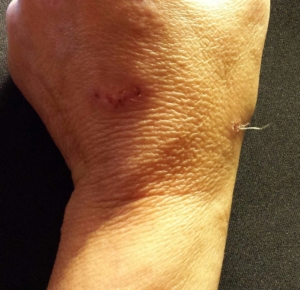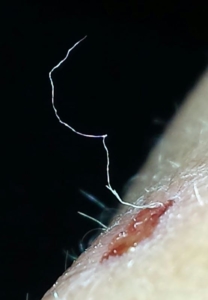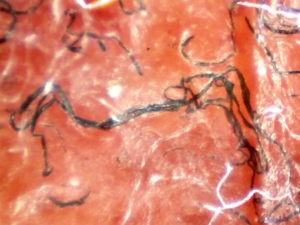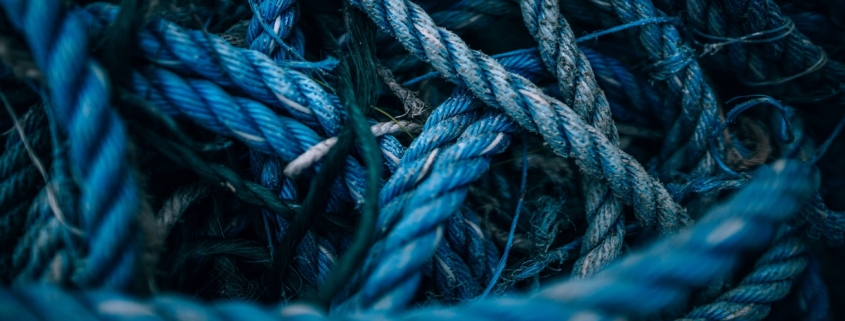What are Morgellons Fibers?
Patients with Morgellons disease make bizarre claims that unusual hairs or fibers are sprouting from their skin. Many of these fibers cling to the skin—especially around the edges of open wounds.
These fantastically colored fibers don’t resemble any filaments naturally produced by mammalian cells, baffling medical professionals. But some doctors simply dismiss them as lint from clothing getting stuck in scabs.
To “prove” that these fibers are real to sometimes contrarian doctors, some patients collect skin debris to show their doctors.
Unfortunately, a patient’s habit of collecting bits of fuzz and skin doesn’t help disprove their illness. Such efforts may actually push a doctor to support a delusional diagnosis!
Join the Charles E. Holman Morgellons Disease Foundation as we take a deep dive into the research surrounding these mysterious Morgellons fibers.
What are Morgellons Fibers?

Morgellons Disease Fiber Extrusion on Leg
Many people suffering from Morgellons disease have been told that the colored fuzz they see around their sores is just lint from towels that adhered to the skin after they bathed. However, further examination of these fibers has shown that collected filaments do not match any of the 880 known compounds used to make textiles.
And the fibers don’t just collect around lesions. Patients experience fibers protruding from the skin all over their bodies—especially around calluses. Adding to the puzzle, researchers can see colored fibers embedded in intact skin when using a handheld 60X magnification light microscope.
Fibers and filaments from Morgellons patients come in wild colors including blue, red, purple, black, white and clear. Most of these colors aren’t seen in mammalian hair, leading many to think they must be from textiles. But medical researchers have used dye-extraction techniques to pull the pigments from these hairs without success. Such efforts would easily discolor textile fibers.
Morgellons fiber structure

Morgellons Disease Fiber Extrusion
Many of the fibers specimens studied show a similar structure to hair strands. The fibers have follicular bulbs and scaling consistent with hairs and grow in or near hair follicles. But not all of the fibers look like hairs; some lack hair-like scaling and are smooth or flattened and wrinkly.
Because pigments can’t be pulled from colorful fiber samples, researchers have concluded that the fibers’ colors are refractory, meaning the structure of the fibers reflect light in such a way that they appear to be colored.
Although purple and blue aren’t colors seen in animal hair, iridescent (a metallic sheen), and refractory colors are consistent with keratin. Keratin is the same class of protein that colors birds’ feathers and is also prevalent in human skin.
Morgellons fiber composition
Morgellons fibers seem to originate from the layer of the skin where hairs grow—the layer where keratinocytes are most active. Keratinocytes are the special skin cells that make keratin, the predominant protein that makes up hair, skin, and nails.
Keratin is a filament protein, meaning it forms long strands that help support cells by acting like scaffolding. Keratin fibers help support tissue cells and give skin its strength and durability. Knowing this, researchers ran several tests to determine Morgellons fiber composition.
Using a special staining technique, researchers applied a keratin-specific dye to fiber samples. When applied to Morgellons fiber samples collected from patients, the researchers discovered that the dye took to the fibers in patches. That means that the fibers are at least partly made of keratin.
Collagen is another fibrous protein that occurs naturally. It’s the primary building block in tissues. Collagen strands create a lattice around cells to offer support and help create connective tissues, muscles, skin, hair and bones.
Suspecting collagen as an ingredient in Morgellons fibers, researchers applied collagen-specific stains to patient samples. Sure enough, the dye colored the non-keratin parts of the fibers. In other words, Morgellons fibers aren’t from textiles at all—the body manufactures them.
Morgellon fiber production

Morgellons Disease Fibers Magnified Specimen
With Morgellons patients, it seems that keratin and collagen-creating cells have run amok, pushing into overdrive to make oversized fibers. But why?
Researchers discovered spirochetes near the misbehaving cells in fiber tissue samples. Plenty of research and documentation point to a spirochetal infection playing a role in Morgellons disease symptoms. Nearly all Morgellons patients test positive for Borrelia burgdorferi, the main player in Lyme disease and other tick-borne bacteria.
Borrelia burgdorferi in particular, has several adaptations that allow it to attach to the outer walls of keratin- and collagen-producing cells. In some instances, the bacteria wiggles its way inside the tissue cells and takes up residence—triggering the protein-producing cells to go berserk and make huge strands of protein.
These proteins grow quickly, sometimes working their way up through the skin. Others grow in a tangle below the surface. It’s entirely possible that the itchy, crawling sensations a Morgellons patient feels are these large filaments growing within their tissues.
Morgellons patients not only experience protruding hairs and open sores, but they also experience problems with finger and toenail growth, joint lesions and disintegrating teeth—structures that are all dependent on healthy keratin and collagen production. In other words, the body is redirecting too much of its supply of keratin and collagen to something less…helpful than joints, nails and hair.
Disputing the CDC
Many Morgellons cynics point to a landmark 2012 Morgellons CDC study that stated that the fiber specimens they collected from Morgellons patients were 83% protein and likely made of superficial skin or cellulose, a plant fiber found in cotton.
However, medical researcher Marianne J. Middelveen (the author of the studies referenced in this post) has pointed out that cellulose is a plant-based carbohydrate, not a protein. If 83% of the sample was made of protein (which is consistent with Middelveen’s findings), that means a small percentage of the sample (less than 17%) was exclusively cellulose and could have come from textile lint stuck to open wounds.
With this detail in mind, the CDC study actually supports the notion that Morgellons fibers are abnormal keratin and collagen strands as both are the most predominant proteins in human tissues.
More research is needed
 Despite major breakthroughs in Morgellons research since 2012, there’s still debate over whether Morgellons disease is even legitimate. Please consider donating to the Charles E. Holman Morgellons Disease Foundation to help us spread awareness through grassroots efforts and research grants.
Despite major breakthroughs in Morgellons research since 2012, there’s still debate over whether Morgellons disease is even legitimate. Please consider donating to the Charles E. Holman Morgellons Disease Foundation to help us spread awareness through grassroots efforts and research grants.
Even small donations can help us find relief for so many patients who are suffering from this debilitating and often disfiguring illness.

